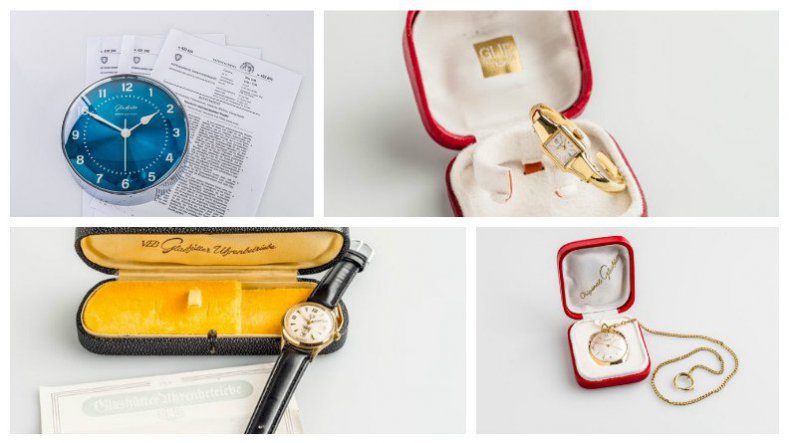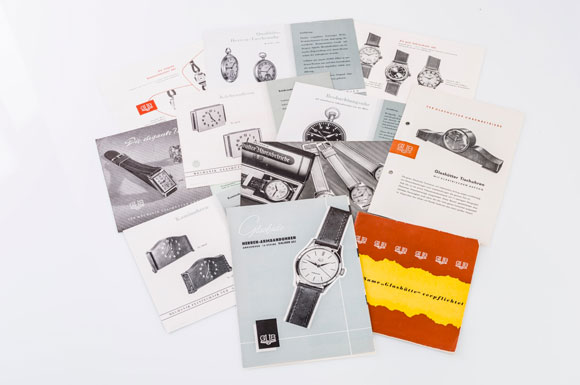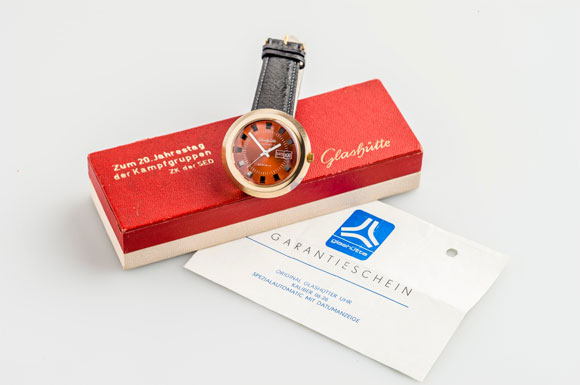In 2006, Glashütte Original, along with the town of Glashütte, established the “German Swiss Replica Watches Museum Glashütte – Nicolas G. Hayek“ foundation, which is responsible not only for the museum’s permanent exhibition, but also for regular special exhibitions focused on various topics related to time and history.
After World War II, from the years 1951 to 1990, all watchmaking companies in Glashütte were organized into the “VEB Glashütter Uhrenbetriebe” (People´s Company Glashütte Watch Companies, VEB GUB or GUB for short). As such, the company made a wide range of products, including wristwatches, marine chronometers, special machines, wall clocks and different types of timers. Until the unification of Germany in 1990, the GUB was the largest employer in the Glashütte region. Glashütte Original was founded when the GUB was privatized in 1994. In the year 2000, the brand became a part of the Swatch Group.
The exhibition is a wide-ranging one, focusing on the products, advertising materials (including original films), development, drawings, tools, special machines, teaching materials and a treasure trove of historic photographs.
To find out more about the exhibition, World Tempus talked to Mr. Reinhard Reichel, Museum Director, Deutsches Uhrenmuseum Glashütte.
WT: How did you choose the exhibits to include in the exhibition?
RR: For this exhibition, we had the chance to look for information in the large archive of Glashütte Original (the former GUB). The company saved significant exhibits and also reference samples of all departments (like the education department, special machines and tool construction, trade fairs, share replica watches and device production, social and cultural life in Glashütte).
Promotion material. © Glashütte Original
What made the GUB so special?
The GUB helped preserve Glashütte’s long tradition in watchmaking and fine mechanics after the end of World War II and the division of Germany. After the German reunification in 1990, all the new founded companies came back to the former specialists of the GUB. Without the GUB, there wouldn´t be a watch fabrication in Glashütte today.
What distinguishes the timepieces made by the GUB during the GDR period?
The whole GDR industry, including GUB, was oriented by a basic philosophy: the goal is to create precise, long-living and robust products for the market. Between the 1950s and 1990s, wrist watches were artifacts of daily use; they belonged to the everyday life. Everybody had a watch. The GUB managed to produce large amounts of watches in demand. A lot of people still use their GUB watches today.
Special Edition of Spezimatic – Task Force. © Glashütte Original
What should people take away from this special exhibition?
Many guests who visit the exhibit have lived and experienced the former GDR. They can identify with what they see. It can be very emotional and lots of memories are brought back. They can say “Yes, it was like this”.
But there are also many guests that come from former West German towns and also from foreign countries. Most of them don´t know anything about the GDR, how people lived, worked, consumed. The exhibition provides insights into what happened to Glashütte after 1945, how the GUB company operated and why there was a chance for further development of watch production in Glashütte after the reunification in 1990.
How has the exhibition been received so far?
After the end of their tour through the exhibition, guests are encouraged to write comments in our visitor’s book. The feedback had been always very positive. The interaction with the Museum staff and tour guides is a two way learning channel. Former employees of the GUB who have visited the Museum enjoy telling us their personal stories and memories. Because of these great reactions, we decided to extend the exhibition until January 10, 2016.
How important was the GUB to the region during the GDR years?
The GUB was definitely the biggest and most important employer in Glashütte and the area around it. The company employed more than 2.500 people in the watch production or device fabrication. The GUB was socially involved in the community and offered many benefits to its employees, including general education, child care, medical care, housing support, cultural and sports events.
What is the legacy of the GUB during those years and can we still see that manifested in today’s Glashütte Original?
Glashütte Original’s know-how and competence is certainly a direct legacy of the GUB. After 1945, with limited access to western technology, GUB watchmakers had to be very creative and find mechanical solutions with the resources available to them. This expertise has been perpetuated and can be seen today throughout all departments of the Glashütte Original manufactory.
The exhibition is currently available for viewing at the German Fake Rolex Watch Museum Glashütte until January 2016.



